Are you a Quiet Speculation member?
If not, now is a perfect time to join up! Our powerful tools, breaking-news analysis, and exclusive Discord channel will make sure you stay up to date and ahead of the curve.
With Kaladesh finally released, and week one of new Modern in the books, it’s time to finally transcend the realm of conjecture and speculation and step out into the world of the physical and tangible. Will Kaladesh “shake up” the Modern landscape we’ve become accustomed to over the past few months? Or will it fade quietly out of the spotlight, disappearing in a cloud of shame and despair, lamenting what could have been, à la Nickelback? Let’s find out!
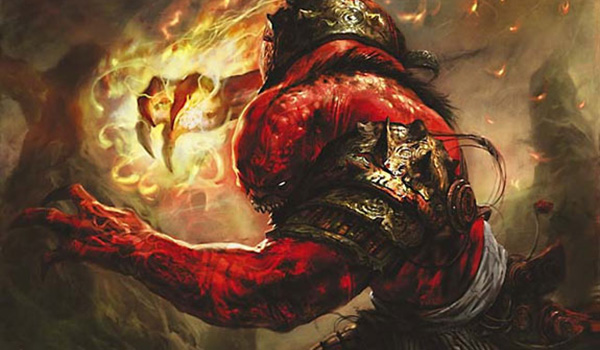
As this is week one of new Modern, we don’t have too much data to analyze. The Star City Games Open in Indianapolis was Standard, but that still leaves us a Modern Classic event’s worth of decklists to dig into. Let’s pop the hood and see if any Kaladesh options are lurking around.
[wp_ad_camp_1]
Infect, by Brad Carpenter (1st, SCG Classic Indianapolis)
Well, that didn’t take long! Infect is no stranger to the winner’s circle. It has been firmly in the top tier of Modern for what seems like ages now and consistently takes home the victor’s trophy every few events. Usually the archetype’s lists are pretty tight, as countless games worth of tuning have narrowed down most of the numbers to a point where the only deviation we usually see is either a result of personal preference or some distinct metagame characteristics necessitating a change.
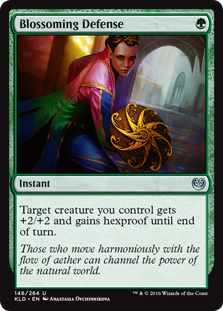 That being said, three copies of Blossoming Defense is without a doubt an exciting new addition to the archetype that should have some experienced Infect players doing a double-take. +2/+2 and hexproof for one green is slightly better than half of a Vines of Vastwood for half the mana, but in reality the difference between one and two mana is more than one, especially in a strategy like Infect. Mana considerations aside, Blossoming Defense is a solid upgrade to Apostle's Blessing, as we definitely would like access to a pump more than we want the ability to Falter a blocker. Especially post-board, when we’ll have non-pump interaction like Nature's Claim and Spell Pierce in our hand, the ability to protect our guy while still pumping for the win is huge.
That being said, three copies of Blossoming Defense is without a doubt an exciting new addition to the archetype that should have some experienced Infect players doing a double-take. +2/+2 and hexproof for one green is slightly better than half of a Vines of Vastwood for half the mana, but in reality the difference between one and two mana is more than one, especially in a strategy like Infect. Mana considerations aside, Blossoming Defense is a solid upgrade to Apostle's Blessing, as we definitely would like access to a pump more than we want the ability to Falter a blocker. Especially post-board, when we’ll have non-pump interaction like Nature's Claim and Spell Pierce in our hand, the ability to protect our guy while still pumping for the win is huge.
Seeing Blossoming Defense in Infect reminds me of Death's Shadow Zoo moving away from Vines of Vastwood. Long considered a fairly regular two-of, Vines eventually disappeared out of Death's Shadow Zoo lists as they pushed to be both more explosive and more streamlined. When everything else in our deck costs one mana (besides Temur Battle Rage) spending GG to pump and save a creature can feel pretty clunky in comparison. In Infect, however, we really want as many protection effects as we can afford, and the number has historically been limited to how many non-pumps we can afford to play. Blossoming Defense solves this problem, enabling us to essentially afford seven protection effects without decreasing the number of pump spells in our deck.
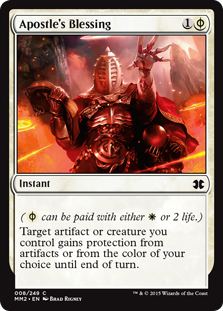 This decklist characteristic, coupled with Brad Carpenter’s strong performance, suggests to me that he was correct in assuming a field reliant on cheap removal to deal with opposing threats. This can be a fallacy, however, as it’s entirely possible that Brad faced a field that went entirely the other way, eschewing removal completely to instead push the velocity of their individual strategies to the max. For the answer to that question, we’ll have to look closely at the makeup of other lists as we move down the line.
This decklist characteristic, coupled with Brad Carpenter’s strong performance, suggests to me that he was correct in assuming a field reliant on cheap removal to deal with opposing threats. This can be a fallacy, however, as it’s entirely possible that Brad faced a field that went entirely the other way, eschewing removal completely to instead push the velocity of their individual strategies to the max. For the answer to that question, we’ll have to look closely at the makeup of other lists as we move down the line.
Moving forward, I would expect Blossoming Defense to continue to see play in place of Apostle's Blessing. Blessing is a fine card, and could still see play week to week depending on a few environmental factors, but Blossoming Defense is softer on our life total and increases our consistency, especially after sideboarding. We really weren’t even taking full advantage of the Falter ability to begin with, as Blighted Agent was already unblockable and Inkmoth Nexus flew over most creatures in the format.
This change carries with it a few cascades, primary among them being the increased power of blockers versus Infect. Lingering Souls was already bad news for any Infect player, but if they start running fewer ways to punish tapping out for blockers, more opponents will begin to take advantage. Tasigur, the Golden Fang has traditionally been a great option versus Infect and probably just got a little better, as it halted Glistener Elf attacks and could apply pressure all while coming down cheaply without opening the caster up to getting blown out.
RG Valakut, by Nathan Adrian (2nd, SCG Classic Indianapolis)
And that’s it. Valakut Breach takes second, with… no new cards. Still, if the Infect list is the metric we’re going off of, four Lightning Bolt, a few Anger of the Gods, and a fast, consistent strategy is kind of where I want to be. 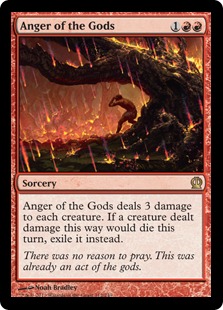 I’ve been dismissive of RG Breach in the past, but with midrange and control operating at a level significantly lower than what they have been in the past, a midrange/combo strategy of our own that beats up on aggressive decks is starting to look really appealing!
I’ve been dismissive of RG Breach in the past, but with midrange and control operating at a level significantly lower than what they have been in the past, a midrange/combo strategy of our own that beats up on aggressive decks is starting to look really appealing!
There's really not that much to say about this deck, because its entire strategy is focused on doing one thing well. Stay alive, ramp, kill things, hit land drops, cast gigantic thing. When it wins, it wins in style, by flinging a ton of Valakut, the Molten Pinnacle triggers at the opponent's face. When it loses, it loses abysmally, at is ramps into nothing or sees hands full of lands, removal and expensive bombs. A deck like this lives and dies based on the list, and at this point, most of the work has already been done. That isn't to say that the deck is easy to play, however. Sideboarding with tight lists like this can be incredibly tough, and any slip in-game is usually enough to cost the match.
Burn, by Arya Roohi (3rd, SCG Classic Indianapolis)
Burn taking third with access to a full playset of Flames of the Blood Hand is a clear sign to me that the format is getting really goldfishy. Besides a few Kitchen Finks and Obstinate Baloth here and there we don’t see much lifegain, so really Arya is using it as a three-mana deal-four. This by itself is actually good enough, supported by other finishes in the past of lists with Flames of the Blood Hand. Sometimes, especially when removal is low and you can count on Goblin Guide to get in two hits, enough “deal-fours” are all you need to get there.
 Besides Flames of the Blood Hand, the biggest thing about this list is what it’s not playing, namely Wild Nacatl and Atarka's Command. By staying relatively mono-color (with white cards in the sideboard) Arya can streamline his manabase. That gives him extra points in aggressive pseudo-mirrors and buys him that pivotal turn to win races.
Besides Flames of the Blood Hand, the biggest thing about this list is what it’s not playing, namely Wild Nacatl and Atarka's Command. By staying relatively mono-color (with white cards in the sideboard) Arya can streamline his manabase. That gives him extra points in aggressive pseudo-mirrors and buys him that pivotal turn to win races.
Still, if we’re banking on a lack of removal in the hopes that our creatures do more than two damage, to the point where we’re looking to play any deal-four we can (even if it costs three) doesn’t that mean that we would want Wild Nacatl? Dealing six is much better than four, and probably worth the extra damage we would take from our lands. So, looking at these results we can infer one of two possibilities. One, the benefits from staying mono-color were conditionally better than trading smoothness for power; or two, my analysis of the format as being removal-light is incorrect, to the point where Wild Nacatl was seen as a drawback, not an incentive.
Finally, the last deck I’d like to discuss today is David Nolan’s Grixis Delver. The only list in the event besides Infect to feature Kaladesh cards, David went the full progressive route by including… two copies of Spirebluff Canal. Easy, killer.
Grixis Delver, by David Nolan (6th, SCG Classic Indianapolis)
If Infect and RG Breach are both strong options, Grixis Delver is the deck I would sleeve up. Our threats are diverse and hard-hitting enough to give Breach’s damage-based removal fits, and our disruption/interaction can buy just enough time for our burn to finish the job. Against Infect, our cheap threats match theirs perfectly, and we have enough removal to just kill things post-combat and make them waste mana. Barring crazy draws, our Infect matchup is really strong, and we even have Izzet Staticaster in the board to seal the deal.
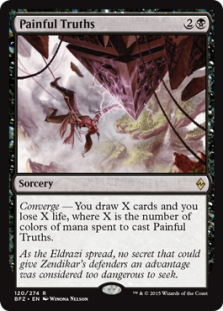 Against the slower decks in the format (should we face them) Painful Truths is a great card to keep up with opposing card advantage, and our identity as the aggressor in those matchups should ensure that the life loss isn’t too awkward for us. All of this is relatively known information at this point, and this Grixis list doesn’t stray too far from the norm with any of its choices. This is fine, though. Grixis Delver does well when the format lines up correctly for it. It isn’t an archetype that is known for being “malleable” and while the numbers can vary significantly from list to list, in a broad sense most things stay relatively the same. Around 15 threats, at least 24 spells, a fair mix of card draw, removal, and permission.
Against the slower decks in the format (should we face them) Painful Truths is a great card to keep up with opposing card advantage, and our identity as the aggressor in those matchups should ensure that the life loss isn’t too awkward for us. All of this is relatively known information at this point, and this Grixis list doesn’t stray too far from the norm with any of its choices. This is fine, though. Grixis Delver does well when the format lines up correctly for it. It isn’t an archetype that is known for being “malleable” and while the numbers can vary significantly from list to list, in a broad sense most things stay relatively the same. Around 15 threats, at least 24 spells, a fair mix of card draw, removal, and permission.
Kaladesh's Impact So Far
So, what sort of takeaways can we draw from this event? To start with, the general lack of Kaladesh cards in lists suggests that Kaladesh might end up being a weak set for Modern. At one point a narrative existed that suggested players might not have access to new cards on events immediately after release, but I don’t think that narrative holds weight anymore. Players in SCG events are more competitive now than ever before, and if they are dropping over $50 on travel/entry/food/etc. to play Magic for a weekend, I find it hard to believe they wouldn’t put up the cash on new cards if they felt it gave them the best chance to win. I’m not going to jump out and give Kaladesh an F based on results from the first weekend, but unless something else pops up, Blossoming Defense isn’t getting anybody excited (sorry Infect players).
As for the conditions of the format, if we look at Infect’s composition (including Vines of Vastwood alongside Blossoming Defense) as well as RG Breach’s assumed strong positioning, it is relatively safe to state that removal is relatively high right now, even given the lack of midrange and control. Going “goldfish” seems to be the general response to the format’s conditions, and most strategies’ success is predicated largely on going fast and resisting disruption. Jeskai Control, Grixis and Jund Midrange, Abzan, and now even Eldrazi are nowhere to be found. In their place, Infect is running rampant (taking four of the top ten slots) and other decks like Affinity, Burn and Storm are putting up strong results as well.
What will end this tide of goldfish decks? What do you think of Kaladesh in Modern? Let me know in the comments below!
Thanks for reading
Trevor Holmes
The_Architect on MTGO
Twitch.tv/Architect_Gaming
Twitter.com/7he4rchitect




I think Kaladesh won’t shake up the upper tiers much, but a lot of the lower tier decks are seeing big shakeups. Lantern Control is seeing massive shakeups, with Glint Nest Crane, Inventors Fair, and the UB artifact scry creature all in contention to break into one of the tightest decklists in the format.
Spark of Creativity is intriguing, too. I’ve seen some discussion by ramp players about if it’s worthwhile, because R to kill a goyf is not a bad deal (if it was instant speed, it’d be unquestionably playable)
I think that what we are seeing is not a failure on the part of Kaladesh, just a lack of time to test and adopt the new technology.
“The only list in the event besides infect to feature Kaladesh cards”
Might want to reread the burn list, it contains one copy of the RW fastland.
Although your general point stands, aside from a few lands and blossoming defense, Kaladesh so far doesn’t seem to have much to offer.
Great article, Trevor! It’s pretty telling how much Blossoming Defense adds to Infect, given that all 4 copies in the t10 were playing 2 or 3 copies main deck.
As far as other cool Kaladesh cards go, I was very excited to see Madcap/Emperion in the SB of the 4th place Storm deck: http://sales.starcitygames.com//deckdatabase/displaydeck.php?DeckID=108138
It seems like a great replacement for Storm’s old Twin transformational sideboard plan.
I have some hopes that Madcap Experiment might go somewhere in Modern. It’s a combo (or whatever you want to call it) with Platinum Emperion that could find a home in Blue Moon or a Jeskai shell. Obviously, it’s vulnerable to bounce and removal (Path, Terminate, Liliana), but with some permission backup, it should be quite powerful.